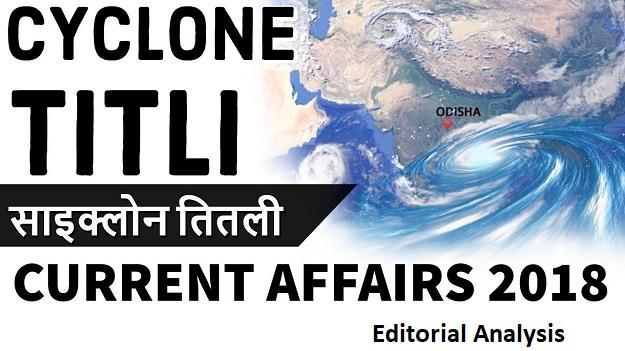HOW WILL THIS IMPACT ODISHA?
The government of Orissa said no death should take place.
- Cyclone Titli intensified into a very severe cyclonic storm(CATEGORY 5) over the Bay of Bengal on Wednesday and is moving towards the Odisha coast, triggering rainfall in several parts of the state, the India Meteorological Department (IMD) said.
- IMD has predicted that the cyclonic wind will badly hit the Andhra Pradesh districts of Visakhapatnam, Vizianagaram and Srikakulam, and the Odisha districts of Gajapati, Ganjam, Puri, and Kendrapara. It has advised fishermen to suspend operations and coastal hutment dwellers to shift to safe places.
- As many as 15 teams of the National Disaster Response Force (NDRF) have been deployed along with the Orissa Disaster Rapid Action Force (ODRAF) at several places across the state
Tropical Cyclone Category System
- CATEGORY 1 (tropical cyclone)Negligible house damage. Damage to some crops, trees, and caravans. Craft may drag moorings.
A Category 1 cyclone’s strongest winds are GALES with typical gusts over the open flat land of 90 – 125 km/h.
These winds correspond to Beaufort 8 and 9 (Gales and strong gales).
- CATEGORY 2 (tropical cyclone)Minor house damage. Significant damage to signs, trees, and caravans. Massive damage to some crops. Risk of power failure. Small craft may break moorings.
A Category 2 cyclone’s strongest winds are DESTRUCTIVE winds with typical gusts over the open flat land of 125 – 164 km/h. These winds correspond to Beaufort 10 and 11 (Storm and violent storm).
- CATEGORY 3 (severe tropical cyclone)Some roof and structural damage. Some caravans destroyed. Power failures likely.
A Category 3 cyclone’s strongest winds are VERY DESTRUCTIVE winds with typical gusts over the open flat land of 165 – 224 km/h.
These winds correspond to the highest category on the Beaufort scale, Beaufort 12 (Hurricane).
- CATEGORY 4 (severe tropical cyclone)Significant roofing loss and structural damage. Many caravans destroyed and blown away. Dangerous airborne debris. Widespread power failures.
A Category 4 cyclone’s strongest winds are VERY DESTRUCTIVE winds with typical gusts over the open flat land of 225 – 279 km/h.
These winds correspond to the highest category on the Beaufort scale, Beaufort 12 (Hurricane).
- CATEGORY 5 (severe tropical cyclone)Extremely dangerous with widespread destruction.
A Category 5 cyclone’s strongest winds are VERY DESTRUCTIVE winds with typical gusts over the open flat land of more than 280 km/h.
These winds correspond to the highest category on the Beaufort scale, Beaufort 12 (Hurricane).
WHY THIS CYCLONE IS NAMED ‘TITLI’
In South East Asia, tropical cyclones are given names by different countries that are located in the region (including South).
Titli was named by Pakistan and the next will called Gaja – named by Thailand.
The process of naming cyclones is done under the supervision of the World Meteorological Organisation.
For the area in and around the Indian Ocean, the talks over naming cyclones started in 2000 and in 2004, a formula was agreed upon.
Eight nations in South and South-East Asia, namely, Bangladesh, India, Maldives, Myanmar, Oman, Pakistan, Sri Lanka, and Thailand have come up with their respective sets of names that are assigned to the cyclone storm in a sequence.
The names of some future cyclones are Gaja (Thailand), Phethai (Sri Lanka), Fani (Bangladesh), Vayu (India), Hikaa (Maldives), Kyarr (Myanmar), Maha (Oman), Bulbul (Pakistan), Pawan (Thailand) and Amphan (Sri Lanka).
WHY IT IS NECESSARY TO NAME CYCLONES?
World Meteorological Organization said :
The naming helps the weather forecaster and general people for an easy communication.
The primary purposes of naming a tropical cyclone or hurricane are for people to easily remember the storm in a region and to better facilitate risk awareness and preparedness.
GUIDELINES FOR NAMING CYCLONES :
- The name should be short and readily understood when broadcast.
- The name should be neutral,‘not culturally sensitive and not convey some unintended and potentially inflammatory meaning.
- Suppose a cyclone came and many people killed (was very disastrous for that country) then that name is retired and never used again.
Not without controversy
- Cyclone Mahasen, which hit in 2013 and was named by Sri Lanka, was changed to Viyaru after protests by nationalists and officials in Sri Lanka.
- They said Mahasen was a king who had brought peace and prosperity to the island, and it was wrong to name a calamity after him.
WHAT’S THE DIFFERENCE BETWEEN HURRICANES, CYCLONES, AND TYPHOONS?
- They’re all the same, officially tropical cyclones.
- But they just use distinctive terms for a storm in different parts of the world.
- Hurricane is used in the Atlantic, Caribbean Sea, central and northeast Pacific.
- They are typhoons in the northwest Pacific.
- In the Bay of Bengal and the Arabia Sea, they are called cyclones. The tropical cyclone is used in the southwest India Ocean.
- In the southwestern Pacific and southeastern India Ocean, they are severe tropical cyclones.
Titli Cyclone will primarily hit Oman.

























 WhatsApp
WhatsApp